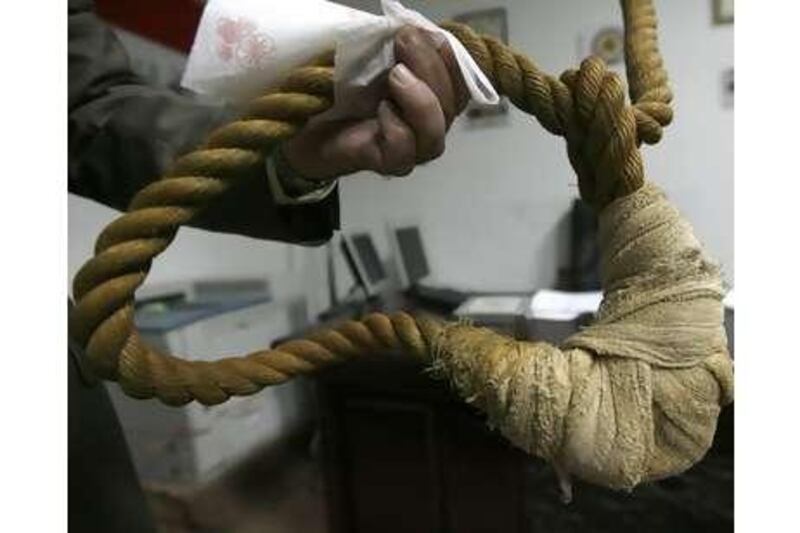BAGHDAD // It is a testament to Saddam Hussein's most heinous crimes, a lasting memory of many of the injustices he and his regime committed. Original maps of the al Anfal military campaign, in which 180,000 Kurds died, a number of bloodied nooses, a steel bar used as a gallows and a metal torture cage are just some of the exhibits that will be on show at the Saddam Hussein museum and study centre.
The centre, which will open in January or February, will be located in the Green Zone, just outside the courthouse where Saddam was found guilty. It aims to provide a lasting legacy of the horrors of the dictator's rule. "There is nothing like this in the Middle East," Judge Areef Abud Raziak, the head of the Iraq High Tribunal that sentenced Saddam to death and the driving force behind the museum, said in an interview.
There will also be a life-size reproduction of the foxhole the former leader was discovered in and all the worldly possessions he had on him at the time - a landline telephone, a copy of the Quran, two novels, a slightly battered briefcase and three tapes. His choices in listening material? Mozart, the Quran and a mix tape of Iraqi gypsy tunes. The study centre will have a bank of computers with all the evidence, more than 26 million documents, presented at his trial. They will be stored on hard drives and translations in Arabic, Kurdish and English will be available for reading.
"You will find it all [the evidence]? We are going to put all the documents [from the trial], the final decision and the execution order here, you will find it all. "People will be able to see his guilt for themselves," said Azeez, a museum worker who would give only his first name. "One day people might forget the crimes of Saddam; they might even forget Saddam. We want to make sure that doesn't happen, to give a lesson to the people," Judge Raziak said.
"The museum is very important, a very important part of our history," said Vian Hamali, 37, who has helped with the layout of the museum. "The suffering of the Iraqi people has to be shown to future generations. The Baath rule was 35 years, which is not a short time. They were destroying and torturing the people," she added. Inside the 200-square-metre building, the private battle map of Sultan Hashem, the military commander of the al Anfal campaign, will hang. The al Anfal, or spoils, was a vicious series of attacks against the Kurds that killed 180,000 people between 1986 and 1989. Kurds were targeted with mustard gas and bombing raids and forced into concentration camps.
The operation was led by Ali Hassan al Majid, nicknamed Chemical Ali for his penchant for chemical weapons, and at times pitted 200,000 Iraqi troops, backed by fighter jets, against a few thousand Kurdish rebels. Many of those killed were civilians. "You know what he said when they told Ali he was responsible for killing 180,000 people? He said: 'No, I just killed 100,000.' Can you believe it?" Azeez said.
There will also be documents from the Dujail case, for which Saddam was hung. "We talk about and show Dujail," Azeez said, referring to the 1982 assassination attempt against Saddam. After the attempt, Saddam ordered his security forces on a rampage through the town. They killed 148 people. The original chair in which Saddam was tried will also be in the museum, as will those of his co-defendants "Chemical Ali" and Tariq Aziz, his deputy prime minister.
There are also several nooses, used by the regime to hang opponents. "There is some blood still on them," Azeez said. One came from Abu Gharib prison, one from the general security office, another from the intelligence office and the final one from the military intelligence service. There is also a metal cage, moulded to fit a human, complete with head covering. It was used to torture athletes who lost.
It was the brainchild of Uday, Saddam's psychopathic son; the athletes were hung in the cage, outdoors in the sun and spun around. To add to the torture the victims were stripped and as the metal bars heated up they burnt their skin. One boxer who lost a fight was kept in the cage for 30 days. "When they gave him his meal they would spin him so he would throw up," Azeez said. He survived the ordeal, but was badly burnt by the metal bars. "He still has some marks," Azeez added.
As the museum will demonstrate, he is far from the only Iraqi still bearing scars. talbone@thenational.ae





